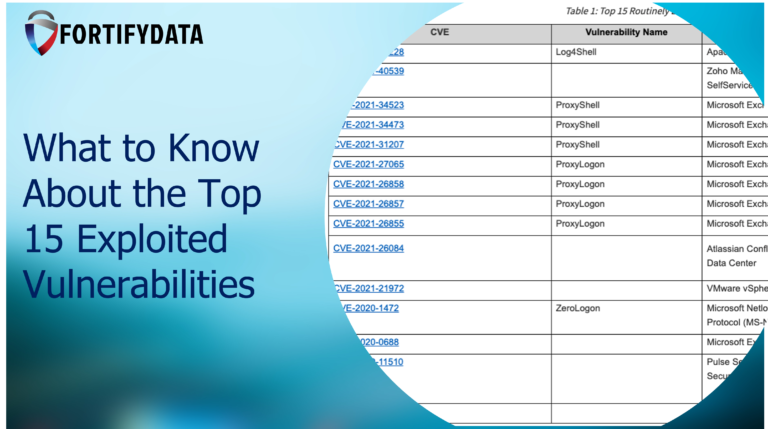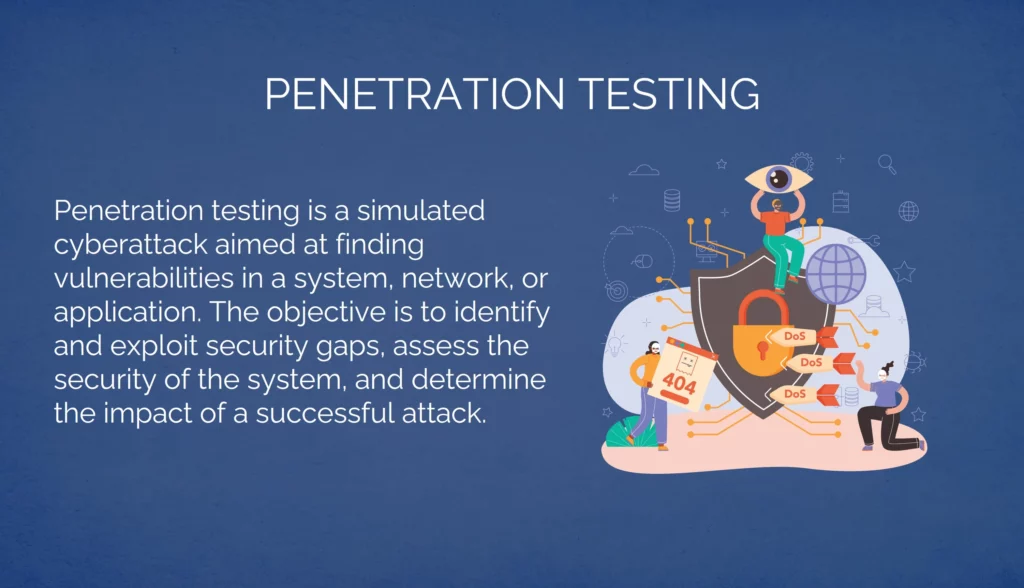
What to Know About the Top 15 Exploited Vulnerabilities A recent joint cybersecurity advisory from U.S and allied cybersecurity authorities identified…
"This is an excellent starting point for any organization that wants to get serious about their cyber risk management. The system has the capability to grow as you become more sophisticated in your use"
IT Director
Services Industry
Penetration testing and vulnerability assessments are two important components of any organization’s cybersecurity strategy. Both aim to identify potential security risks, but they do so in different ways. Understanding the difference between these two methods is essential to developing a comprehensive security plan that protects your organization’s assets and data.
What is Penetration Testing?

Penetration testing, also known as pen testing, is a simulated cyberattack aimed at finding vulnerabilities in a system, network, or application. Pen testers use a variety of techniques, including manual and automated testing, to identify weaknesses in their targets. The objective is to identify and exploit security gaps, assess the security of the system, and determine the impact of a successful attack.
Pen testing typically follows a structured approach, beginning with reconnaissance and mapping the target’s attack surface. The tester then attempts to exploit vulnerabilities, either by manual or automated means, to gain unauthorized access to the system. The final stage of the pen test is to evaluate the results and provide recommendations for remediation. Organizations that hire firms to conduct penetration testing do so to also validate the remediation of identified vulnerabilities as part of a continuous threat exposure management (CTEM) strategy.
Pen testing can provide organizations with valuable insights into their security posture, but it has its limitations. Pen tests are typically performed on a one-time basis as part of an audit or other requirement, and the results are only applicable to the time and circumstances of the test.
What are Vulnerability Assessments?
Vulnerability assessments, also known as vulnerability scans, are automated tools that identify potential security risks in a system, network, or application. Vulnerability assessments use scanning technology to identify and prioritize vulnerabilities in the target. The objective of a vulnerability assessment is to identify potential security risks that could be exploited by threat actors and provide recommendations for remediation.
Vulnerability assessments are less invasive than pen testing and do not involve attempting to exploit vulnerabilities. Instead, they focus on identifying and prioritizing potential security risks in the target. Vulnerability assessments can be performed on a regular basis, allowing organizations to monitor their security posture and respond to potential threats in a timely manner.
One of the key benefits of vulnerability assessments is that they provide organizations with a comprehensive view of their security posture. This enables organizations to identify and prioritize potential security risks and take proactive measures to mitigate them. Vulnerability assessments can also be performed on a regular basis, allowing organizations to monitor their security posture and respond to potential threats in a timely manner.
Another benefit of vulnerability assessments is that they are less intrusive than pen testing. Vulnerability assessments do not involve attempting to exploit vulnerabilities, and they do not disrupt the normal operation of the target. This makes them an ideal choice for organizations that need to maintain the integrity of their systems, networks, and applications.
FortifyData’s Risk-based Vulnerability Management
FortifyData can conduct continuous external and internal vulnerability assessments for clients on agreed upon intervals, usually weekly. This is done as part of a broader attack surface management strategy, so organizations stay up to date with the vulnerabilities affecting the assets that keep their business up and running. The findings of these attack surface and vulnerability assessments help our clients identify changes to asset inventory and highlight any new vulnerabilities associated to the assets.
The FortifyData platform also combines the assessment findings with asset classification and is enriched with cyber threat intelligence to provide a prioritized view of risks. A prioritized view of cyber risks lists the most impactful cyber risk to the organization in a priority order. This enables teams to focus on the risk and vulnerabilities affecting the most critical resources to business operations.
Like the definitions above stated, these assessments are non-intrusive and don’t exploit the findings so as not to disrupt operations. A good attack surface and vulnerability management program will make it more difficult for threat actors to exploit identified vulnerabilities (they should be remediated) to gain a foothold for further reconnaissance or deploying a malware payload. Additionally, this will make any penetration test more informative since the team will have to work a bit harder to gain access. We recommend companies evolve to a continuous threat exposure management program, so they are continually updated about the threats posed to their business.
Vulnerability Assessments and Penetration Testing Work Hand-in-Hand
Penetration testing and vulnerability assessments are both important components of a comprehensive security strategy, but they serve different purposes. Pen testing provides organizations with a snapshot of their security posture at a specific point in time, while vulnerability assessments are automated tools that identify potential security risks in a system, network, or application. Both methods have their strengths and limitations. By combining the strengths of both methods, organizations can develop a more comprehensive security plan that increases their security maturity and resilience that protects against a wide range of potential threats.



| Cookie | Duration | Description |
|---|---|---|
| cookielawinfo-checkbox-analytics | 11 months | This cookie is set by GDPR Cookie Consent plugin. The cookie is used to store the user consent for the cookies in the category "Analytics". |
| cookielawinfo-checkbox-functional | 11 months | The cookie is set by GDPR cookie consent to record the user consent for the cookies in the category "Functional". |
| cookielawinfo-checkbox-necessary | 11 months | This cookie is set by GDPR Cookie Consent plugin. The cookies is used to store the user consent for the cookies in the category "Necessary". |
| cookielawinfo-checkbox-others | 11 months | This cookie is set by GDPR Cookie Consent plugin. The cookie is used to store the user consent for the cookies in the category "Other. |
| cookielawinfo-checkbox-performance | 11 months | This cookie is set by GDPR Cookie Consent plugin. The cookie is used to store the user consent for the cookies in the category "Performance". |
| viewed_cookie_policy | 11 months | The cookie is set by the GDPR Cookie Consent plugin and is used to store whether or not user has consented to the use of cookies. It does not store any personal data. |